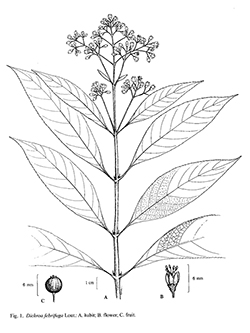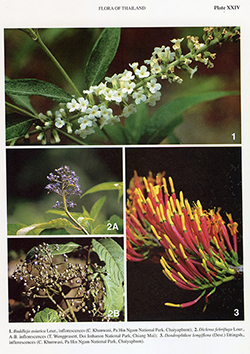e-Flora of Thailand
Volume 7 > Part 4 > Year 2002 > Page 662 > Hydrangeaceae > Dichroa
Dichroa febrifuga Lour.wfo-0001229927
Fl. Cochinch.: 301. 1790; C.B.Clarke in Hook.f., Fl. Brit. Ind. 2: 206. 1879; Brand., Ind. Trees: 297, f. 126. 1978; Lecomte, Fl. Gén. I.-C. 2: 688, f. 68. 1920; Ridl., Fl. Malay Penins. 1: 681. 1922; O.Lecompte in FL. C.L.V. 4: 30. 1965. Fig. 1; Plate XXIV: 2A–B.
Accepted Name : Hydrangea febrifuga (Lour.) Y.De Smet & Granados
Taxon 64: 750. 2015.
Description : Undershrub, 1–2.50 m high; bark greyish-brown, with large pith. Leaves elliptic, obovate to oblanceolate, 13–20 by 5–9 cm, apex acuminate, base cuneate or attenuate, margin serrate, sparsely pubescent on both surfaces; nerves 8–11 pairs, finely arched and more or less anastomosing near margin; petiole slender, 2–5 cm long, sparsely hairy, then glabrescent. Panicles pubescent, 6–15 cm long, 5–10 cm wide; peduncle 5–10 cm long; pedicel ca 1 cm long; calyx-tube, 6–8 toothed, campanulate, glabrous inside, sparsely hairy outside. Petals 4–7, oblong or ovate, acute or obtuse; pale to dark blue, glabrous, 6–7 by 2.5–3 mm. Stamens 10 or 20, epigynous, filaments adherent to the corolla; filaments glabrous, filiform 4–5 mm long; anthers oblong or ovate, ca 2 mm long, blue, longitudinally dehiscent. Ovary ovoid or conical. Styles ca 5 mm long. Stigmas blue. Berry globose, ca 5 mm diam; sparsely hairy to glabrous; intense glossy blue when ripe, crowned by the persistent calyx and styles. Seeds numerous, small, obovoid, reticulate.
Thailand : NORTHERN: Chiang Mai (Doi Monchong, Doi Suthep, Doi Ang Khang, Doi Inthanon, Doi Pha Hom Pok), Nan (Doi Phukha), Tak (Umphang); NORTH-EASTERN: Loei (Phu Kradueng); SOUTH-EASTERN: Chanthaburi (Khao Soi Dao); SOUTH-WESTERN: Kanchanaburi (Kwae Noi River, Thung Yai Naresuan WS); PENINSULAR: Chumphon (Khao Nom Sao), Ranong (Khao Phota Luang Kaeo), Surat Thani (Kao Naung), Krabi (Khao Phanom Bencha), Nakhon Si Thammarat (Khao Luang), Trang (Khao Chong); Narathiwat (Bala-Hala Widlife Sanctuary).
Distribution : Tropical and subtropical Asia (from Nepal and N India to S China, Vietnam, Cambodia, Malesia, Indonesia, the Philippines and Papua New Guinea).
Ecology : Seasonal rain forests on clayey soil and often along streams up to the montane evergreen forests, from 200–2,000 m alt.
Vernacular : Hom dong (ฮอมดง), hom kham (ฮอมคำ), yai krang (ยายกรัง)(Peninsular).
Uses: Decoction of the whole plant is used as an emetics and anti-febrifuge.


